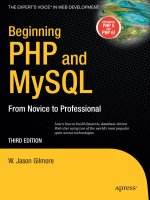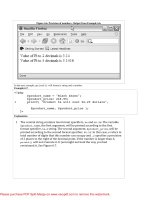PHP and MySQL tutorial
Bạn đang xem bản rút gọn của tài liệu. Xem và tải ngay bản đầy đủ của tài liệu tại đây (297.65 KB, 40 trang )
PHP/MySQL Tutorial
PHP/MySQL Tutorial
Introduction to Database
Goal of this tutorial
Goal of this tutorial
Not to teach everything about PHP, but provide the basic
knowledge
Explain code of examples
Provide some useful references
PHP == ‘Hypertext Preprocessor’
Open-source, server-side scripting language
Used to generate dynamic web-pages
PHP scripts reside between reserved PHP tags
This allows the programmer to embed PHP
scripts within HTML pages
What is PHP?
What is PHP?
What is PHP (cont’d)
What is PHP (cont’d)
Interpreted language, scripts are parsed at run-
time rather than compiled beforehand
Executed on the server-side
Source-code not visible by client
‘View Source’ in browsers does not display the PHP
code
Various built-in functions allow for fast
development
Compatible with many popular databases
What does PHP code look like?
What does PHP code look like?
Structurally similar to C/C++
Supports procedural and object-oriented
paradigm (to some degree)
All PHP statements end with a semi-colon
Each PHP script must be enclosed in the
reserved PHP tag
<?php
…
?>
Comments in PHP
Comments in PHP
Standard C, C++, and shell comment symbols
// C++ and Java-style comment
# Shell-style comments
/* C-style comments
These can span multiple lines */
Variables in PHP
Variables in PHP
PHP variables must begin with a “$” sign
Case-sensitive ($Foo != $foo != $fOo)
Global and locally-scoped variables
Global variables can be used anywhere
Local variables restricted to a function or class
Certain variable names reserved by PHP
Form variables ($_POST, $_GET)
Server variables ($_SERVER)
Etc.
Variable usage
Variable usage
<?php
$foo = 25; // Numerical variable
$bar = “Hello”; // String variable
$foo = ($foo * 7); // Multiplies foo by 7
$bar = ($bar * 7); // Invalid expression
?>
Echo
Echo
The PHP command ‘echo’ is used to output the
parameters passed to it
The typical usage for this is to send data to the
client’s web-browser
Syntax
void echo (string arg1 [, string argn ])
In practice, arguments are not passed in parentheses
since echo is a language construct rather than an
actual function
Echo example
Echo example
Notice how echo ‘5x5=$foo’ outputs $foo rather than replacing it with 25
Strings in single quotes (‘ ’) are not interpreted or evaluated by PHP
This is true for both variables and character escape-sequences (such as
“\n” or “\\”)
<?php
$foo = 25; // Numerical variable
$bar = “Hello”; // String variable
echo $bar; // Outputs Hello
echo $foo,$bar; // Outputs 25Hello
echo “5x5=”,$foo; // Outputs 5x5=25
echo “5x5=$foo”; // Outputs 5x5=25
echo ‘5x5=$foo’; // Outputs 5x5=$foo
?>
Arithmetic Operations
Arithmetic Operations
$a - $b // subtraction
$a * $b // multiplication
$a / $b // division
$a += 5 // $a = $a+5 Also works for *= and /=
<?php
$a=15;
$b=30;
$total=$a+$b;
Print $total;
Print “<p><h1>$total</h1>”;
// total is 45
?>
Concatenation
Concatenation
Use a period to join strings into one.
<?php
$string1=“Hello”;
$string2=“PHP”;
$string3=$string1 . “ ” .
$string2;
Print $string3;
?>
Hello PHP
Escaping the Character
Escaping the Character
If the string has a set of double quotation marks that must remain
visible, use the \ [backslash] before the quotation marks to ignore
and display them.
<?php
$heading=“\”Computer Science\””;
Print $heading;
?>
“Computer Science”
PHP Control Structures
PHP Control Structures
Control Structures: Are the structures within a language that
allow us to control the flow of execution through a program or
script.
Grouped into conditional (branching) structures (e.g. if/else) and
repetition structures (e.g. while loops).
Example if/else if/else statement:
if ($foo == 0) {
echo ‘The variable foo is equal to 0’;
}
else if (($foo > 0) && ($foo <= 5)) {
echo ‘The variable foo is between 1 and 5’;
}
else {
echo ‘The variable foo is equal to ‘.$foo;
}
If Else
If Else
If (condition)
{
Statements;
}
Else
{
Statement;
}
<?php
If($user==“John”)
{
Print “Hello John.”;
}
Else
{
Print “You are not John.”;
}
?>
No THEN in PHP
While Loops
While Loops
While (condition)
{
Statements;
}
<?php
$count=0;
While($count<3)
{
Print “hello PHP. ”;
$count += 1;
// $count = $count + 1;
// or
// $count++;
?>
hello PHP. hello PHP. hello PHP.
Date Display
Date Display
$datedisplay=date(“yyyy/m/d”);
Print $datedisplay;
# If the date is April 1
st
, 2009
# It would display as 2009/4/1
2009/4/1
$datedisplay=date(“l, F m, Y”);
Print $datedisplay;
# If the date is April 1
st
, 2009
# Wednesday, April 1, 2009
Wednesday, April 1, 2009
Month, Day & Date Format Symbols
Month, Day & Date Format Symbols
M Jan
F January
m 01
n 1
Day of Month d 01
Day of Month J 1
Day of Week l Monday
Day of Week D Mon
Functions
Functions
Functions MUST be defined before then can be
called
Function headers are of the format
Note that no return type is specified
Unlike variables, function names are not case
sensitive (foo(…) == Foo(…) == FoO(…))
function functionName($arg_1, $arg_2, …, $arg_n)
Functions example
Functions example
<?php
// This is a function
function foo($arg_1, $arg_2)
{
$arg_2 = $arg_1 * $arg_2;
return $arg_2;
}
$result_1 = foo(12, 3); // Store the function
echo $result_1; // Outputs 36
echo foo(12, 3); // Outputs 36
?>
Include Files
Include Files
Include “opendb.php”;
Include “closedb.php”;
This inserts files; the code in files will be inserted into current code.
This will provide useful and protective means once you connect to a
database, as well as for other repeated functions.
Include (“footer.php”);
The file footer.php might look like:
<hr SIZE=11 NOSHADE WIDTH=“100%”>
<i>Copyright © 2008-2010 KSU </i></font><br>
<i>ALL RIGHTS RESERVED</i></font><br>
<i>URL: </i></font><br>
PHP - Forms
PHP - Forms
•
Access to the HTTP POST and GET data is simple in PHP
Access to the HTTP POST and GET data is simple in PHP
•
The global variables $_POST[] and $_GET[] contain the
The global variables $_POST[] and $_GET[] contain the
request data
request data
<?php
if ($_POST["submit"])
echo "<h2>You clicked Submit!</h2>";
else if ($_POST["cancel"])
echo "<h2>You clicked Cancel!</h2>";
?>
<form action="form.php" method="post">
<input type="submit" name="submit" value="Submit">
<input type="submit" name="cancel" value="Cancel">
</form>
/>
WHY PHP – Sessions ?
WHY PHP – Sessions ?
Whenever you want to create a
Whenever you want to create a
website
website
that allows you to store and display
that allows you to store and display
information about a user, determine which user groups a person belongs to,
information about a user, determine which user groups a person belongs to,
utilize permissions on your
utilize permissions on your
website
website
or you just want to do something cool on
or you just want to do something cool on
your site,
your site,
PHP's
PHP's
Sessions
Sessions
are vital to
are vital to
each
each
of these features.
of these features.
Cookies are about 30% unreliable right now and it's getting worse every day.
Cookies are about 30% unreliable right now and it's getting worse every day.
More and more web browsers are starting to come with security and privacy
More and more web browsers are starting to come with security and privacy
settings and people browsing the net these days are starting to frown upon
settings and people browsing the net these days are starting to frown upon
Cookies because they store information on their local computer that they do
Cookies because they store information on their local computer that they do
not want stored there.
not want stored there.
PHP has a great set of functions that can achieve the same results of Cookies
PHP has a great set of functions that can achieve the same results of Cookies
and more without storing information on the user's computer. PHP Sessions
and more without storing information on the user's computer. PHP Sessions
store the information on the web server in a location that you chose in
store the information on the web server in a location that you chose in
special files. These files are connected to the user's web browser via the
special files. These files are connected to the user's web browser via the
server and a special ID called a "Session ID". This is nearly 99% flawless in
server and a special ID called a "Session ID". This is nearly 99% flawless in
operation and it is virtually invisible to the user.
operation and it is virtually invisible to the user.
PHP - Sessions
PHP - Sessions
•
Sessions store their identifier in a cookie in the client’s browser
Sessions store their identifier in a cookie in the client’s browser
•
Every page that uses session data must be proceeded by the
Every page that uses session data must be proceeded by the
session_start()
session_start()
function
function
•
Session variables are then set and retrieved by accessing the global
Session variables are then set and retrieved by accessing the global
$_SESSION[]
$_SESSION[]
•
Save it as
Save it as
session.php
session.php
<?php
<?php
session_start();
session_start();
if (!$_SESSION["count"])
if (!$_SESSION["count"])
$_SESSION["count"] = 0;
$_SESSION["count"] = 0;
if ($_GET["count"] == "yes")
if ($_GET["count"] == "yes")
$_SESSION["count"] = $_SESSION["count"] + 1;
$_SESSION["count"] = $_SESSION["count"] + 1;
echo "<h1>".$_SESSION["count"]."</h1>";
echo "<h1>".$_SESSION["count"]."</h1>";
?>
?>
<a href="session.php?count=yes">Click here to count</a>
<a href="session.php?count=yes">Click here to count</a>
/>
Avoid Error PHP - Sessions
Avoid Error PHP - Sessions
PHP Example:
PHP Example:
Correct
Warning: Cannot send session cookie - headers already sent by
(output started at session_header_error/session_error.php:2)
in session_header_error/session_error.php on line 3
Warning: Cannot send session cache limiter - headers already
sent (output started at
session_header_error/session_error.php:2) in
session_header_error/session_error.php on line 3









